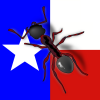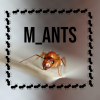Scientific Name: Pseudomyrmex gracilis
Common Names: Elongate twig ants, twig ants, mexican twig ants
Distribution: Native to: Texas, Mexico, Venezuela, Colombia, Ecuador, Guyana, Suriname, French Guiana, Brazil, Peru, Bolivia, Uruguay, Argentina, Paraguay, Belize, Guatemala, Honduras, El Salvador, Nicaragua, Costa Rica, and Panama. (There are no records in Chile but it is likely to be native there too)
Dubious in: Chihuahua, Sonora, and Sinaloa. (Northwestern Mexico) & West Bengal (Bangladesh)
Invasive to: Hawaii, Florida, South Carolina, Mississippi, Tennessee, Alabama, Louisiana, Jamaica, Hispaniola (Haiti/Dominican Republic), Lesser Antilles, & Trinidad and Tobago. Likely to be invasive to Georgia state as well.
Indoor Introduced to: California, United Kingdom, Netherlands.
Queen size: ~11 mm
Worker size: ~9 mm
Male size: ~11 mm
Natural Habitat: Tight spaces. Twigs, oak galls, rotting wood, extremely rarely inside homes.
Circadian Activity: Very diurnal. Rarely are out at night unless they are dealing with prey. Once the colony gets larger, they will start to actively forage during the day and night.
Mating Flight: Mating happens from March - November. Mostly found from May - August.
Queen Founding Method: Semi-Claustral
Monogyne or Polygyne: Monogyne. They do not tolerate multiple fertile queens in their nest.
Average time from egg to worker: Egg to Larva - ~5 days, Larva to Pupa - ~25 days, Pupa to Worker - ~10 days
Recommended Temperature: These ants love heat. Their room temperature is 70° - 75° F (~21° to ~23.9° C). I run a thin 80° F (~26.7° C) heat cable along the opposite end of the nest from their water source to keep them warm (This is totally optional but they like it in my case). Keep in mind that the entire nest should not be heated like that, or moisture will evaporate causing the ants extreme unrest.
Recommended Humidity: They prefer very dry nests. When keeping them in TarheelAnts nests, do not put any water in the water tower. Filling the Nestmate is encouraged so that they can drink and it can provide for small amounts of moisture, so long as the Nestmate is not close to their heat source.
Preferred Foods: Offer a constant supply of honey, and always cut up protein other than fruit flies.
Hibernation Details: These tropical ants, so they do not hibernate. They will slow down brood production during colder months, but will still forage a bit.
Escape Barrier Methods: Fluon (PTFE). This is the only barrier that I know of that keeps them contained. These ants are escape artists and great climbers, so I would always at least recommend an air tight lid.
Difficulty Rating: 6/10
Reasons why:
Semi-Claustral queens
Queens are typically found foraging, which means all of the brood they've been raising prior to you catching them will be lost.
Very good escape artists (Airtight lidded outworld w/ Fluon strongly recommended)
Queens are difficult to distinguish from workers
This species’ stings can be pretty painful.
Rapid and unpredictable movements due to their amazing vision.
Bite & Sting Rating: ~5/10. This species bites and stings. They usually bite before following up with a sting. Even if they fall on you, they take a few seconds before they even try to sting you. If you are intentionally aggravating their nest(s), you’re just asking to be stung. Bites don’t really hurt. Stings can be quite painful, but are not on Myrmecia or Paraponera clavata level of pain.
Special Care or Interesting Notes:
These ants have excellent vision, and can detect you from multiple feet away.
Most likely able to chew through Ytong.
They hate airflow, if you want to move them create airflow in the undesirable area.
They are heat lovers, but don’t scorch them alive.
When the colony is smaller in scale, the queen will likely take part in foraging.
They are solo foragers, so they will appreciate larger outworlds.
The outworld likely needs to have a strong barrier such as Fluon (PTFE) applied, and have an air tight lid if you want feeding/containing them to be easy. TarheelAnts' "Premium Desert Scene" or Empire of Ants' outworlds work fantastic.
I find the best setup is an airtight outworld connected via tubing to a Mini-Hearth Type III.
If the colony’s alates fail to fly, the males will die or be eaten, and the queen alates will get their wings ripped off and act as workers or be killed.
They much prefer dead protein sources, except for fruit flies once the colony is bigger.
The queen will often be elected as a replete in the colony, workers like to give her lots of honey/other sweets. This can also make her easily identifiable when the colony starts growing quickly.
Additional Links:
http://antwiki.org/w...myrmex_gracilis
http://www.antmaps.o...myrmex.gracilis
https://www.antweb.o...is&rank=species
Information submitted by Ants_Texas
Edited by dspdrew, March 5 2022 - 8:10 PM.






















